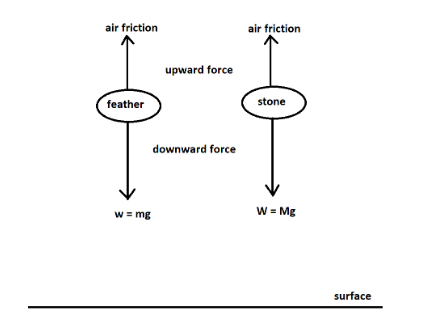
A stone and a feather dropped from the same height do not reach the ground at the same time.
Reason : Acceleration due to gravity is dependent on the mass of the object.
A. if both assertion and reason are true and reason is the correct explanation of assertion.
B. if both assertion and reason are true and reason is not the correct explanation of assertion.
C. if assertion is true but reason is false.
D. if both assertion and reason are false.
Answer
575.7k+ views
Hint: To solve this question, we have to remember that air friction will work here as air resistance and the total force acting on the body will be equal to weight of the body – air friction.
Complete answer:
We have given that,
A stone and a feather dropped from the same height do not reach the ground at the same time.
and the given reason behind this assertion is that Acceleration due to gravity is dependent on the mass of the object.
So,
First, we will find out the force acting on the feather.
Here, a downward force will act on the feather, whose magnitude will be equal to the weight of the feather, i.e.
$w = mg$, where m is the mass of the feather and g is the acceleration due to gravity.
Here, the air friction will work as air resistance for the feather,
So, another force will also act on the feather which is opposite to the motion, i.e. upward force.
Hence, the total force acting on the feather,
$ \Rightarrow {F_{feather}} = $w – air friction.
Similarly, we can find the total force acting on the stone.
The downward force acting on the stone will be,
$W = Mg$, where M is the mass of stone and g is the acceleration due to gravity.
The upward force will be the air friction.
So, the total force acting on the stone will be,
$ \Rightarrow {F_{stone}} = $W – air friction.
It is obvious that, mass of the stone is greater than the mass of feather, i.e. M > m.
Therefore, W > w.
Hence, ${F_{stone}} > {F_{feather}}$.

Now, we can say that the assertion is true but the reason, acceleration due to gravity is dependent on the mass of the object is false.
So, the correct answer is “Option C”.
Note:
When a body falls freely towards the surface of the earth, its velocity continuously increases. The acceleration developed in its motion is called acceleration due to gravity. When a body is in free fall, a gravitational pull mg does act on it. It is said to be weightless because it exerts no force on its support.
Complete answer:
We have given that,
A stone and a feather dropped from the same height do not reach the ground at the same time.
and the given reason behind this assertion is that Acceleration due to gravity is dependent on the mass of the object.
So,
First, we will find out the force acting on the feather.
Here, a downward force will act on the feather, whose magnitude will be equal to the weight of the feather, i.e.
$w = mg$, where m is the mass of the feather and g is the acceleration due to gravity.
Here, the air friction will work as air resistance for the feather,
So, another force will also act on the feather which is opposite to the motion, i.e. upward force.
Hence, the total force acting on the feather,
$ \Rightarrow {F_{feather}} = $w – air friction.
Similarly, we can find the total force acting on the stone.
The downward force acting on the stone will be,
$W = Mg$, where M is the mass of stone and g is the acceleration due to gravity.
The upward force will be the air friction.
So, the total force acting on the stone will be,
$ \Rightarrow {F_{stone}} = $W – air friction.
It is obvious that, mass of the stone is greater than the mass of feather, i.e. M > m.
Therefore, W > w.
Hence, ${F_{stone}} > {F_{feather}}$.

Now, we can say that the assertion is true but the reason, acceleration due to gravity is dependent on the mass of the object is false.
So, the correct answer is “Option C”.
Note:
When a body falls freely towards the surface of the earth, its velocity continuously increases. The acceleration developed in its motion is called acceleration due to gravity. When a body is in free fall, a gravitational pull mg does act on it. It is said to be weightless because it exerts no force on its support.
Recently Updated Pages
Master Class 11 Business Studies: Engaging Questions & Answers for Success

Master Class 11 Computer Science: Engaging Questions & Answers for Success

Master Class 11 Maths: Engaging Questions & Answers for Success

Master Class 11 Chemistry: Engaging Questions & Answers for Success

Master Class 11 Economics: Engaging Questions & Answers for Success

Master Class 11 Accountancy: Engaging Questions & Answers for Success

Trending doubts
What is meant by exothermic and endothermic reactions class 11 chemistry CBSE

10 examples of friction in our daily life

One Metric ton is equal to kg A 10000 B 1000 C 100 class 11 physics CBSE

1 Quintal is equal to a 110 kg b 10 kg c 100kg d 1000 class 11 physics CBSE

Difference Between Prokaryotic Cells and Eukaryotic Cells

What are Quantum numbers Explain the quantum number class 11 chemistry CBSE




